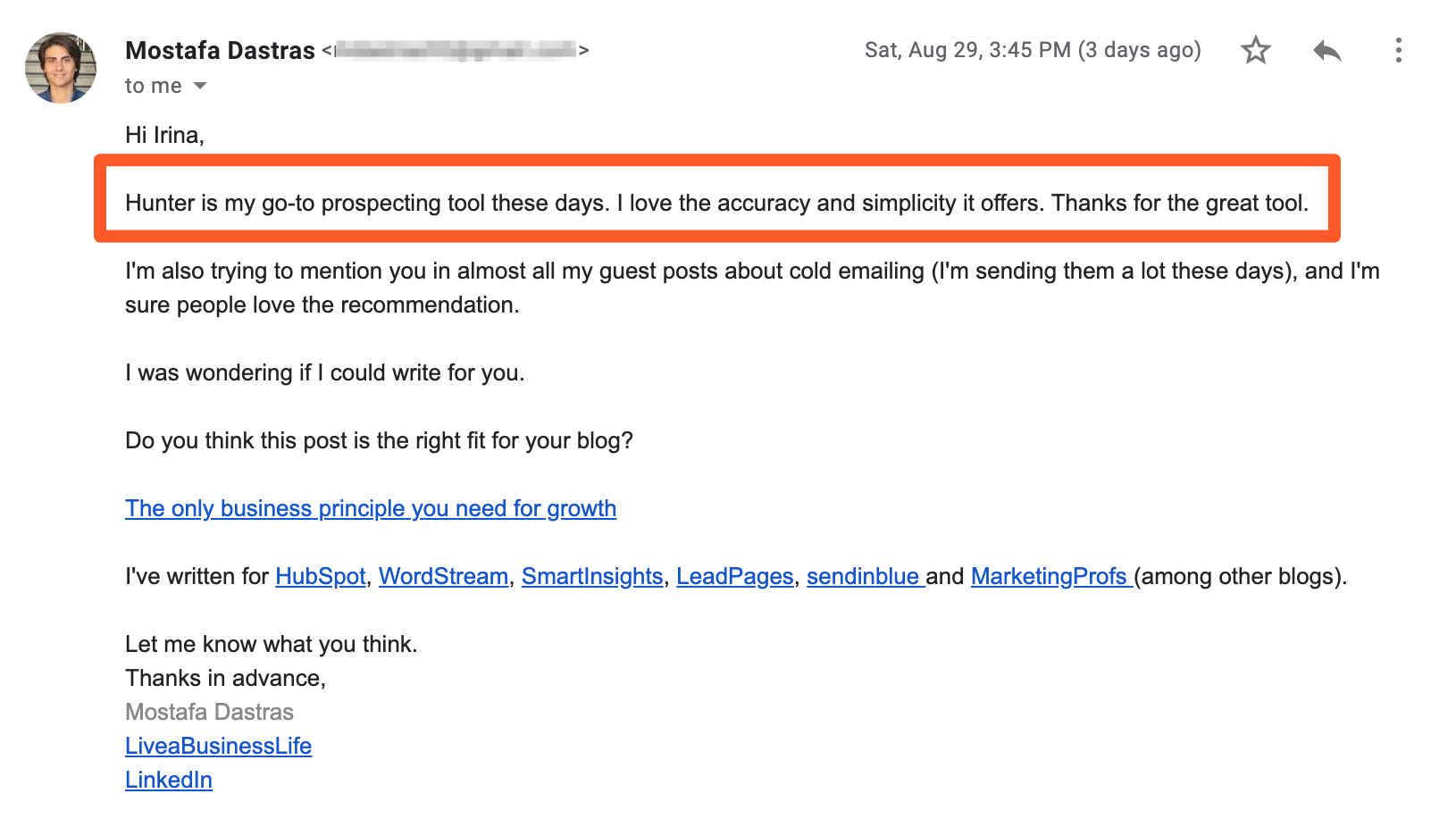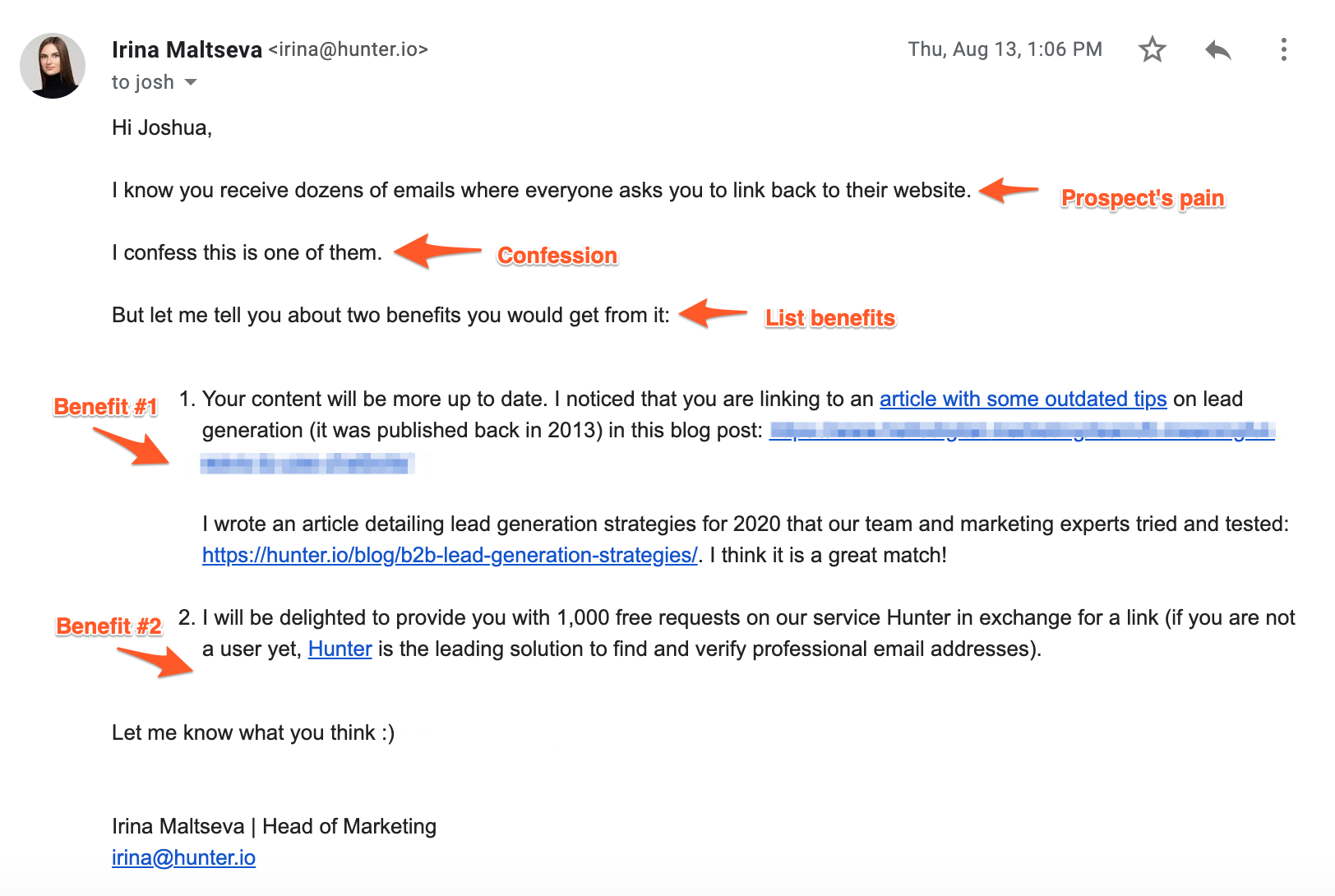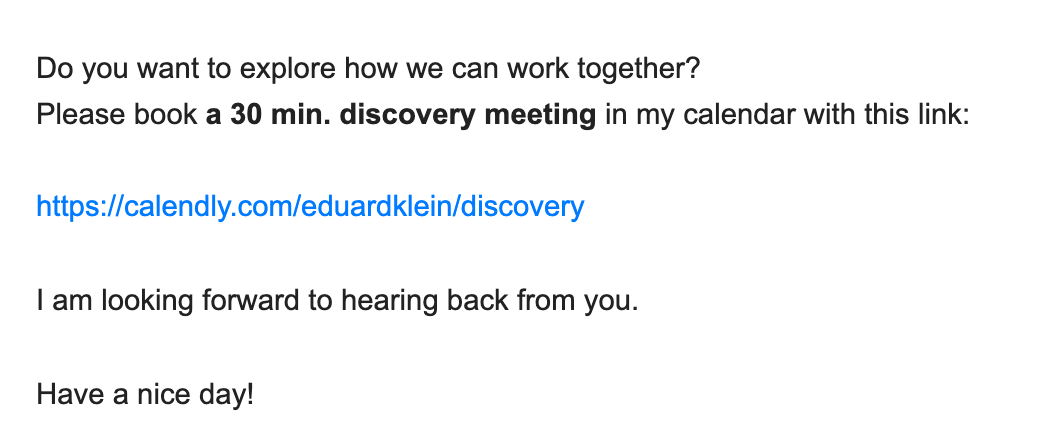14 Sales Pitch Examples: How to Create a Sales Pitch That Converts

What makes you want to buy something? Be honest—how many times have you listened to a sales rep, and then bought something you might not have bought otherwise?
You listened to a great sales pitch.
A sales pitch is a short presentation of what you have to offer, followed by a request that the recipient work with you. Every sales pitch is unique, but they all follow the same basic structure.
Knowing how to write a well-crafted sales pitch is a crucial skill for sales reps and critical to any business’ success.
We’ve covered a lot of different kinds of emails here on the blog, specifically sales-related emails like follow-ups. Sales pitches are the most overt kind of sales email—they’re the ones that directly ask for sales.
In this blog post, we’re going to show you how to create a great sales pitch and provide you with 14 sales pitch examples you can use to help you craft your own pitch.
What does a good sales pitch look like?
At a glance, a good sales pitch is one that converts the people who receive it. Going deeper than that, a successful sales pitch includes four important components that drive people to convert:
- Research
- Brevity
- Data
- Urgency
Here’s a closer look at the key traits all effective sales pitches share:
Highly researched
What kind of sales pitches result in the most sales? Those that are personalized for the recipient.
There’s more to it—but ultimately, the deciding factor for your sales pitch email’s success is whether you took the time to research the prospect, their company, their needs, and the solution that would serve them best.
A personalized sales pitch is more than a sales pitch that leads with the recipient’s name. It addresses their specific pain points and offers solutions that are feasible for their budget, type of business, and specific needs.

For example, if your offer is enterprise-level software to make bookkeeping easier for large corporations, your target recipient isn’t a small bagel shop with two employees.
So how do you determine who, exactly, is the right fit for your offer? You do your research.
Use all the resources available to learn everything you possibly can about each prospect. That includes their website, social media profiles, any available information about their business, and who is in charge of making buying decisions.
For that last piece of research, we have a great blog post on strategies for finding the email addresses you need to find for specific people in an organization.
Short
An effective sales pitch email is also short. It needs to be just long enough to make a connection with the recipient by explaining the problem you solve and the kinds of customers you serve. This should take, at maximum, a paragraph or two.
This type of sales pitch is sometimes called the elevator pitch.
A concise sales pitch should include three core elements:
Hook
The hook is the moment your pitch captures the prospect’s attention. If your pitch doesn’t hook the prospect within the first few seconds of them opening your email, they will be a lot less likely to convert.
We’ve discussed effective hooks on the blog before. The right hook or opening line for your pitch depends on your offer and the recipient—which is why you need to do enough research on them to understand what kind of hook will work best.
The right hook might be a personal note, like mentioning that you spoke with them at an event a few days prior. Or it might be a statistic they just can’t ignore, like the results your product generated for your other clients in the past six months.
Here’s a sales pitch example with a great hook that we received at Hunter:

Context
After hooking your reader, you need to explain why you’re pitching to them. Maybe it’s because you noticed they struggle with a specific pain point, or maybe it’s because you have a new product available, and they had a great experience with the last product you released.
Mention your value proposition — how your offer will help them resolve a pain point.
There are a few different strategies you can use to do this, like mentioning how well it worked for other clients, dropping a few key facts and statistics about your offer’s efficacy, including a testimonial, or simply asking the prospect how you can help them.
Whichever strategy you determine is best, the goal is to get the reader to visualize themselves using your product to resolve the challenges they’re currently facing.
Be sure to keep your pitch clear, concise, and free from jargon. The prospect needs to completely understand your offer, and they can’t do that if it’s loaded with technical terms or bogged down by convoluted sentences.
Keep it short, keep it clear, and keep it in the simplest language you can use to communicate your offer and its benefits.

Call to action
This last part is where you actually ask the recipient to make a purchase (or, if your email’s goal is to get them on a sales call, ask them to schedule a call with you).
This part needs to be straightforward, clear on exactly what you want the recipient to do (e.g., watch a demo, schedule a call, subscribe, or buy a product), and give short instructions on how to do it.
Your call to action needs to have a sense of urgency—you just pitched them on why your offer is so great; now drive them to take action while it’s fresh in their mind.

Uses data
Data is your friend. And when it comes to sales pitches, data is one of your best friends because data convinces people.
Think about it—how many times have you heard a claim, then looked it up and found data that convinced you that the claim was true (or false? Or technically true, but cherry picked?)
Similarly, how many times have you argued a point by citing relevant data to support it?
We’d wager a guess you’ve done that at least a few times.
Just like citing statistics makes your argument more persuasive, citing data makes your sales pitch more effective. And as the company offering the product or service, you should have all the relevant data to back up your claims.
Include data that illustrates the value your offer delivers. This data gives the recipient the information they need to come to their own conclusion about your offer: ideally, that it will solve the challenges they’re facing right now.
Here are some examples of data you could include in your pitch:
- Sales figures from previous releases or promotions
- Customer feedback about your product or service
- Case studies about previous products or releases
This data can be about the customer, too. For example, you might include statistics on the kinds of brands that choose to work with you or the demographics your company serves.
By seeing themselves in your satisfied customer base, your email’s recipient is more likely to connect with your brand.
Creates a sense of urgency
As we mentioned above, an effective sales pitch creates a sense of urgency. Urgency comes from the vocabulary the pitch uses and how the message is structured.
Ask yourself this: do these phrases make me want to buy something?
- When you get a chance
- If you’re ready
- Before the end of this promotion
- I’d like to connect
No, right?
How about these?
- Now
- This promotion ends soon
- Ready?
- Call now
Short, action-oriented words and sentences create a sense of urgency. Whatever you say in your sales pitch, say it in as few words as possible. Make sure you use the active voice, too.
Here’s a quick primer on the active voice versus the passive voice:
- Active: Smart people buy this product
- Passive: This product is purchased by smart people
See the difference? Your sales pitch needs to be clear, direct, and urgent.
This is also a great place to address your recipient’s pain point again. For example, if you’re offering IT services, remind them how much a network outage will cost them for every hour it persists.
What NOT to include in a sales pitch
Just like there are certain components that need to be in every sales pitch, there are a few things that shouldn’t be in any sales pitch you send. Always avoid:
Sales cliches
Sales cliches: you’ve heard ‘em all.
“Buy now and save!”
“Don’t miss out on this AMAZING opportunity!”
“Act now before it’s gone”
When you’re writing a sales pitch that not only hooks potential buyers, but also creates the necessary sense of urgency to get them to buy your offer, it can be easy to wander into cliche territory.
After all, there are only so many ways to tell somebody to buy something. So how do you use a tried-and-true sales formula without sounding like every other sales pitch the recipient has heard?
Stay away from cliche expressions like:
- Bang for your buck
- Move the needle
- Addressing the elephant in the room
- Win-win scenario
If you find yourself wanting to use one of these stock phrases, determine what you’re really trying to say. Then, find a fresher way to communicate your point.
For example, instead of starting your sales pitch with “let’s address the elephant in the room,” you might start it with something like “I know what you’re worried about, and trust me, you aren’t the only one.”
Too many technical details
As we mentioned above, leave the industry-specific jargon out of your sales pitch. There’s one very specific exception to this rule, which we’ll illustrate in one of the example templates later on.
But in most cases, including technical details in your sales pitch will make the prospect less likely to convert, not more.
That’s because people want to feel confident that they’re choosing the right product for their needs. If they come across a term or figure they don’t understand, they won’t be as confident that they’re making the right choice.
Remember, your sales pitch should always affirm that choosing you is the best choice the prospect can make.
There’s another reason why including too many technical details in your pitch will detract from its effectiveness: they take up space.
When people read emails, they skim. That’s why it’s so important to grab their attention with a personalized hook and make them want to read the whole thing. But when someone is skimming an email and seeing nothing but figures and details they can’t immediately understand, their attention wanes.
And when people lose interest, you lose the sale. So make sure that when you do include technical information and other details in your pitch, you include them because they’ll connect with the prospect and make them more excited about your offer.
Promises you can’t keep
This one is critical. Of course, you want to make your sales pitch as appealing to the recipient as possible. You want to make them offers they can’t refuse.
But make sure those are offers you’re actually willing and able to deliver.
There are two ways you can potentially land yourself in hot water by making promises you can’t keep:
- Making unrealistic claims about your product or service
- Offering add-ons, discounts, or other upgrades you can’t actually provide
In the first case, making a false claim can result in buyers feeling disappointed in your product and, potentially, in dangerous situations themselves if the product doesn’t work how you claimed it would work.
Depending on where in the world you and the buyer are located, this could lead to legal trouble for you. In the second scenario, you can similarly find yourself in legal trouble for fraud—and your reputation as a business destroyed.
Even if you do make a sale, making a promise you can’t keep will only result in an unsatisfied customer.
14 sales pitch examples to inspire your next pitch
Need inspiration for your next pitch? Check out these 14 great sales pitch examples:
1. Quick win for {{company}}
This kind of pitch is ideal for the customer who wants something right now. In addition to offering a solution that will instantly net them results, it gives them two tactical strategies for free.
If your goal is to net a new client rather than retain an existing one, giving them something for free can be a very effective way to establish your value and trustworthiness as a brand.
After taking advantage of the two suggestions and seeing their results, the recipient will want more—and they’ll book a call with you to get it.
2. Solution for [[challenge]]
Naturally, a sales pitch is all about offering a solution. And that’s exactly what this template equips you to do.
In some cases, the most effective way to hook the prospect is to jump right into their problem and how your solution will resolve it.
Notice how in this template, the sender immediately backs up their solution with relevant data about past clients’ experiences.
If the only information you have about the prospect is the challenges they’re facing, or if that’s really the only information that’s relevant to your pitch, keep it simple and go with a pitch like this.
3. How do you handle [[problem]]?
In contrast to the last template, this one asks the prospect to have a conversation with the sender about the challenges they’re facing.
If you don’t know the exact nature of the prospect’s challenges, a sales pitch like this can help you do your research while offering a solution. It might lead to a call where you determine that the prospect actually isn’t a great fit for your service—or that they’d be served better by one of your other products.
4. Showcase {{company}} to 730K+ potential customers
This is the kind of pitch that can work great if you’re targeting an established or otherwise high-value prospect.
By leading with an acknowledgment that they’re doing amazing things, you’re opening the door to express how your offer can only help them keep growing and enable them to be even better at what they do.
You’re also making your value immediately clear with a quick stat: you’ve got the power to put their brand in front of a large number of potential buyers.
5. {{first_name}} check out your new cancellation flow
Some products are best demonstrated rather than discussed. If that’s your product, opt for a sales pitch that shows, rather than tells, how it will solve the challenges the prospect is facing.
Also, notice how the sender tells the recipient exactly how long the video is. Nobody wants—or has time—to watch a long video on how your product works.
So by telling them before they click that it will only take 40 seconds of their time, you’re assuring them that you respect their time and won’t take a second more than you need.
6. Sales team goals
The purpose of this kind of sales pitch isn’t to embarrass the prospect if they aren’t meeting their goals; it’s to acknowledge that lower-than-expected sales are a pain point that you’re equipped to solve.
This is another example of the kind of pitch that you should only employ if your research has shown that this specific issue is one the prospect is struggling with.
7. Quick question on {{company}} {{first_name}}
If you’re marketing to other marketers, you can “speak their language” in a sales pitch. You can’t do this when you’re pitching to people outside your industry or your role.
But when you know your prospect will understand certain vocabulary words, concepts, and concerns, you can jump right to the jargon and talk to them marketer-to-marketer.
Doing this communicates that you’ve been in the same position they’re in now and that you’re offering them a solution that’s truly designed for somebody in their position.
8. Available for a chat?
Similar to example #3, this pitch invites the prospect to tell you about the pain points they’re experiencing, rather than you assuming them.
The difference here is that this pitch feels more casual and suggests a more person-to-person, rather than company-to-company, connection between you and the prospect. Use this kind of pitch for a smaller or sole proprietor prospect.
9. Let's build your A-team
Certain sales pitches are best suited for products. Others are best suited for services. This template is an example of the latter type of pitch because it does two things:
- It name-drops top players who’ve used the service, implicitly including the prospect in that list
- It includes data on the results the service has garnered for those past clients
Use this kind of sales pitch if you’ve got an impressive client list and the data to back up your claims.
10. Help with [[problem]]
This kind of pitch wastes no time introducing the sender. If you’re pitching to a cold prospect, this is the strategy to use.
There’s only one question the prospect should be asking when they reach the end of your email: how soon can we schedule the call?
11. Hi {{first_name}}, quick question
Just like the previous sales pitch template, this one starts by introducing the sender. It’s another great choice for a cold prospect.
This one gets more personal, though, first with an honest compliment about the prospect’s company and then a personal connection. If you have either of these, leverage them. That’s one of the most effective ways to personalize a sales pitch.
12. [[problem]] solution
Another way to leverage your brand’s resources is to have your testimonials sell your offer. That’s what this sales pitch does.
It gets straight to the point, telling the prospect that you know what they do and what they struggle with—this shows that you did your research, which goes a long way in establishing trust.
Then, after the pitch, the testimonial does the talking, followed by a promise that the prospect, too, can have this great experience.
13. {{company} + [[your company]]
This is another sales pitch template that hinges primarily on a question rather than going straight to the offer. The offer is subtle here: just a quick sentence about what you do, no pressure on the recipient to take you up on it at all.
This kind of pitch is ideal for offers that are best explained through a conversation rather than a one-way email.
14. Are you happy with [[competitor]]?
If it’s appropriate for your brand (and this kind of tactic isn’t appropriate for every brand—and that’s perfectly fine!), ask the prospect about their experience with a competitor directly.
This is where your research comes in handy—by taking the time to learn about what your prospect’s company does and the services they’re currently working with, you can get personal in your sales pitch like this.
Remember, you aren’t badmouthing your competitor in this kind of sales pitch. Instead, you’re asking the prospect for their honest feedback about their experience with the competitor, good and bad.
And when they mention the difficulties they’ve faced, that’s your opportunity to offer a solution.
Get the most out of your sales pitch
Writing effective sales pitches is part science, part art. There are the components that need to be there, like an irresistible hook and a direct call to action. But there are also the components that can vary a little, like the statistics you include to support your offer.
As you test and redevelop your sales pitch framework, remember that selling involves more than just an irresistible offer. That offer is only irresistible if it’s personalized for the people receiving it.
And even when it is irresistible, sometimes people still need a little nudge to say yes and move forward with the deal. That’s why you almost always need to send a follow-up email within a few days of sending your initial sales pitch.
Need more help crafting a sales pitch? Check out our database of sales pitch templates here.




 Send cold emails with Hunter
Send cold emails with Hunter